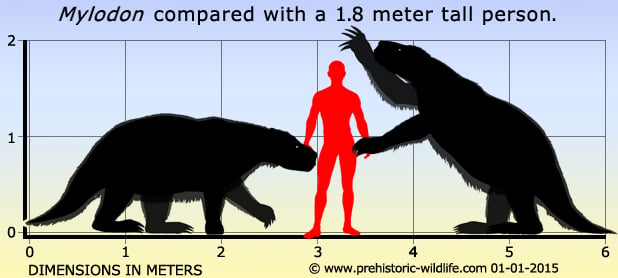In Depth
Compared to other giant ground sloths Mylodon is closely related to Glossotherium. While analysis of dung samples has confirmed it was a herbivore, Mylodon would have also been especially resilient to attack from predators due to the presence of thick bony plates called osteoderms. These osteoderms were just under the skin and in the living animal, unseen due to Mylodon’s hairy body. Large claws on the hands usually relied upon for feeding could also have been used with devastating consequences against any predators that attempted to attack it.
Mylodon inhabited a broad range of habitats with varying climatic conditions which has resulted in some confusion as to how such a seemingly adaptable creature could go extinct. One theory could be hunting from ancient humans that had made their way across the Bering land bridge and down through North America into Central and South America. Human hunters would have been intelligent enough to locate vulnerable parts of the body and then use their weapons to hit them. Another possibility could be a change in South America’s general climate that may have triggered a change in the flora (plant life). This could have indirectly affected Mylodon as its preferred food plants became scarce, resulting in starvation from increased competition with other herbivores as well as increased contact and conflict with others.
Hair and even dung from Mylodon has been readily found and dated to ten thousand years ago. However because these remains were so well preserved they were thought by some to have come from a recently deceased animal that suggested Mylodon was still alive during the early twentieth century. Despite the fact they have been accurately dated to ten thousand years ago, rumours still persist about Mylodon’s continued survival.
Further Reading
– Nuevos restos de mam�feros f�siles Oligocenos recogidos por el Profesor Pedro Scalabrini y pertenecientes al Museo Provincial de la ciudad del Parana. – Bolet�n de la Academia Nacional de Ciencias de C�rdoba 8:1-205. – F. Ameghino – 1885. – Informe preliminar de los progresos del Museo La Plata, durante el primer semestre de 1888. – Boletim del Museo de La Plata II:1-35. – F. P. Moreno – 1888. – Mylodon darwini Owen (Xenarthra, Mylodontinae) from the Late Pleistocene of Mesopotamia, Argentina, with Remarks on Individual Variability, Paleobiology, Paleobiogeography, and Paleoenvironment. – Journal of Vertebrate Paleontology 30(5):1547-1558. – Diego Brandoni, Brenda S. Ferrero & Ernesto Brunetto – 2010.











